- HOME
- Reagents
- Cell Culture
- Cell Reservoir One (Vitrify)
A novel serum-free cell culture freezing medium for vitrification method
Cell Reservoir One (Vitrify)
Vitrification has become an important alternative to standard slow programmable
freezing methods for cryopreservation of primate ES cell lines including
Human iPS cells because of the higher survival rates of cells after thawing.
However, the vitrification requires an ultra-rapid freezing protocol, usually
less than 15 seconds between making cell suspensions and freezing in liquid
nitrogen.
Cell Reservoir One (Vitrify) is a novel serum-free cell culture freezing
medium for vitrification method, which contains a water-soluble glycoprotein
SERICIN isolated from the silkworm cocoon as a major constituent. It provides
high survival rates of primate cells, such as Monkey ES cells and Human
iPS cells even with a longer freezing protocol; up to 60 second from the
cell collection to freezing in liquid nitrogen.
*Cell Reservoir One (Vitrify) is produced in corporation with SEIREN. (Patent pending)
Features
-
High viability with a longer freezing protocol (up to 60 seconds)
-
Low toxicity to cells (DMSO and acetamide free)
Application 1
Comparison of survival rate of Hunan iPS cells (201B7 cell line*)
*Takahashi, K. et al. Cell, 2007 Nov 30;131(5):861-872
Freezing protocol: 60 seconds
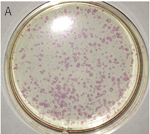 |
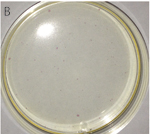 |
A: Cell Reservoir One (Vitrify) B: DAP213 |
Human iPS cells were cryopreserved for more than 2 weeks in Cell Reservoir One (Vitrify) or DAP213. Viability was detected using Alkaline Phosphatase 4 days after thawing. Cell Reservoir One (Vitrify) showed high survival rate, while most of cells in DAP213 were dead.
Freezing protocol: 15 seconds
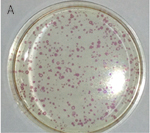
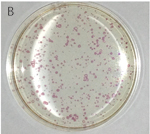
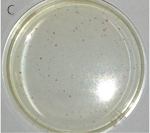
A: Cell Reservoir One (Vitrify)
B: DAP213
C: Company A
Human iPS cells were cryopreserved for more than 2 weeks in Cell Reservoir One (Vitrify), DAP213 or Company A’s product. Viability was detected using Alkaline Phosphatase 4 days after thawing. Cell Reservoir One (Vitrify) showed the highest viability.
Data courtesy of a customer
Conclusion
Cell Reservoir One (Vitrify) showed high viability with both 15 and 60 seconds of freezing protocol. With 60 seconds protocol, the survival rate of cells in Cell Reservoir One (Vitrify) was significantly higher than other freezing media.
| A | Cell Reservoir One (Vitrify) | 672 | 563 | - |
| B | DAP213 | 37 | 479 | - |
| C | Company A | - | - | 172 |
| Freezing Medium | The Number of Colony | |||
|---|---|---|---|---|
| Vitrification Method | Slow Freezing Method | |||
| 60 Seconds | 15 Seconds | |||
Application 2
Comparison of recovery ratio in primate stem cells
Cell Reservoir One (Vitrify) showed higher recovery ratio of Human iPS cells and Common Marmoset ES cells compared to DAP213.
Recovery ratio of Human iPS cells (253G1 cell line*) after vitrification
*Nakagawa, M. et al. Nat Biotechnol, 2008 Jan;26(1):101-106
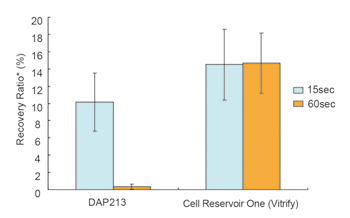
Data courtesy of Fukui University
Recovery ratio of Common Marmoset ES cells (CMES 40 cell line*) after vitrification
*Sasaki, E. et al. Stem Cells, 2005 Oct;23(9):1304-1313
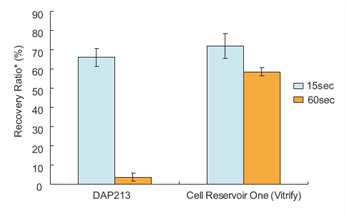
Data courtesy of Fukui University
*Recovery ratio (%) =
100 x the number of colonies after vitrification and thawing / the number
of colonies at general passage
Application 3
Comparison of recovery ratio of Human iPS cells (253G1 cell line) with competitors’
Human iPS cells were cryopreserved for 2 hours with 15 seconds freezing protocol in each company’s freezing medium. Recovery ratio was evaluated 4 days after thawing. Cell Reservoir One (Vitrify) showed the highest recovery ratio.
Data courtesy of Fukui University
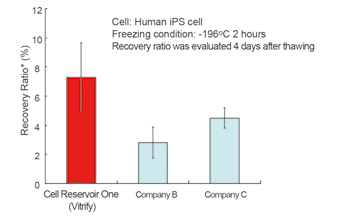
Data courtesy of Fukui University
*Recovery ratio (%) =
100 x the number of colonies after vitrification and thawing / the number
of colonies at general passage
Application 4
Comparison of recovery ratio in Human iPS cells (253G1 cell line) and examination of their undifferentiated state
Cell Reservoir One (Vitrify) showed higher recovery ratio compared to DAP213. The time of freezing protocols (15 seconds
or 60 seconds) did not affect the recovery rate of cells in Cell Reservoir One (Vitrify). Expression of undifferentiated marker
gene was also confirmed.
Data courtesy of Fukui University
Recovery ratio
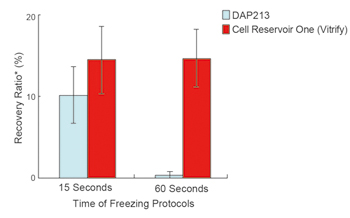
*Recovery ratio (%) =
100 x the number of colonies after vitrification and thawing / the number
of colonies at general passage
Alkaline phosphatase activity
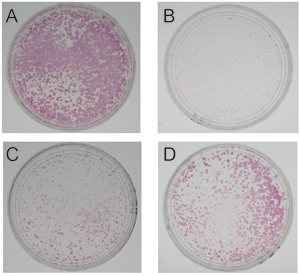
A :Unfrozen
B :FBS/10%DMSO (Frozen by slow freezing method)
C :DAP213 (Vitrification method, 15 seconds freezing protocol)
D :Cell Reservoir One (Vitrify)
(Vitrification method, 15 seconds freezing protocol)
Expression of undifferentiated marker gene
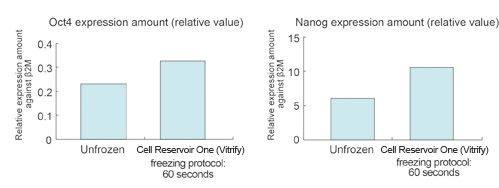
β2M: β2 microglobulin
Data courtesy of Fukui University
Ordering information
| Product name | Storage | Product No. | PKG Size | Online Catalog |
|---|---|---|---|---|
| Cell Reservoir One, Vitrify | 4°C | 11325-62 | 25 ml |
(Storage) R: Refrigerator
SERICIN, a major constituent of Cell Reservoir One, is produced by SEIREN.
Related Products
(Storage) R: Refrigerator F: Freezer